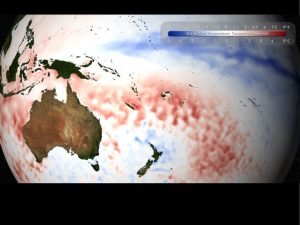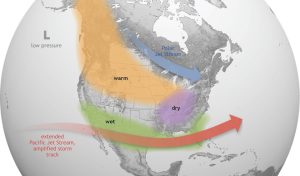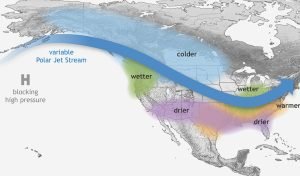05 Sep 2022 El Niño and La Niña.
GS Paper 1: Important Geophysical phenomena such as earthquakes, Tsunami, Volcanic activity, cyclone etc., geographical features and their location-changes in critical geographical features (including water-bodies and ice-caps) and in flora and fauna and the effects of such changes.
News: In what may be termed as an uncommon phenomenon, La Ninã conditions prevailing over the equatorial Pacific Ocean since September 2020 have entered the third year. There are only six instances of La Ninã lasting for more than two years since the 1950s , data with the India Meteorological Department (IMD) show.
What is La Niña in weather?
- La Niña is a climate pattern that describes the cooling of surface ocean waters along the tropical west coast of South America.
- La Nina is considered to be the counterpart to El Nino, which is characterized by unusually warm ocean temperatures in the equatorial region of the Pacific Ocean.
- La Nina brings warmer-than-normal sea-surface temperatures (in red) to the southern Pacific Ocean around northern Australia, New Guinea, and the islands of Indonesia.
- The cooler sea-surface temperatures of La Nina (in blue) occur in the southern Pacific off the coast of South America.

What are the conditions which causes La Nina?
- La Niña is caused by a build-up of cooler-than-normal waters in the tropical Pacific, the area of the Pacific Ocean between the Tropic of Cancer and the Tropic of Capricorn. Unusually strong, eastward-moving trade winds and ocean currents bring this cold water to the surface, a process known as upwelling.
- Upwelling can cause a drastic drop in sea-surface temperature. Coastal sea-surface temperatures near Ecuador and Peru dropped nearly 4 degrees Celsius (7 degrees Fahrenheit) during the 1988-89 La Niña event.
What are El Niño and La Niña?
- El Niño: During El Niño, trade winds weaken. Warm water is pushed back east, toward the west coast of the Americas. El Niño means Little Boy, or Christ Child in Spanish. South American fishermen first noticed periods of unusually warm water in the Pacific Ocean in the 1600s. The full name they used was El Niño de Navidad, because El Niño typically peaks around December. El Niño can affect our weather significantly. The warmer waters cause the Pacific jet stream to move south of its neutral position. With this shift, areas in the northern U.S. and Canada are dryer and warmer than usual. But in the U.S. Gulf Coast and Southeast, these periods are wetter than usual and have increased flooding.
- El Niño has a strong effect on marine life off the Pacific coast: During normal conditions, upwelling brings water from the depths to the surface; this water is cold and nutrient rich. During El Niño, upwelling weakens or stops altogether. Without the nutrients from the deep, there are fewer phytoplankton off the coast. This affects fish that eat phytoplankton and, in turn, affects everything that eats fish. The warmer waters can also bring tropical species, like yellowtail and albacore tuna, into areas that are normally too cold.

- La Niña: La Niña means Little Girl in Spanish. La Niña is also sometimes called El Viejo, anti-El Niño, or simply “a cold event.” La Niña has the opposite effect of El Niño. During La Niña events, trade winds are even stronger than usual, pushing more warm water toward Asia. Off the west coast of the Americas, upwelling increases, bringing cold, nutrient-rich water to the surface. These cold waters in the Pacific push the jet stream northward. This tends to lead to drought in the southern U.S. and heavy rains and flooding in the Pacific Northwest and Canada. During a La Niña year, winter temperatures are warmer than normal in the South and cooler than normal in the North. La Niña can also lead to a more severe hurricane season. During La Niña, waters off the Pacific coast are colder and contain more nutrients than usual. This environment supports more marine life and attracts more cold-water species, like squid and salmon, to places like the California coast.

What is EL Nino Southern Oscillation(ENSO)?
- ENSO is a series of linked weather- and ocean-related phenomena. The El Nino-Southern Oscillation (ENSO) is an irregular cycle of change in wind and sea surface temperatures over the tropical eastern Pacific Ocean, affecting the climate of much of the tropics and subtropics. The warming phase of the sea temperature is known as El Nino and the cooling phase as La Nina.
- Together, La Niña and El Niño are the “cold” (La Niña) and “warm” (El Niño) phases of the El Nino-Southern Oscillation (ENSO).
- Besides unusually warm or cool sea-surface temperatures, ENSO is also characterized by changes in atmospheric pressure.
How does La Nina (El Viejo or cold event) impact India’s monsoon?
- La Nina is observed when the water temperature in the Eastern Pacific gets comparatively colder than normal, as a consequence of which, there is a strong high pressure over the eastern equatorial Pacific.
- The difference in pressure between Eastern Pacific and Western Pacific/Asia causes a moisture-laden wind movement from East to West Pacific and Asia.
- As a result, La Nina causes drought in the South American countries of Peru and Ecuador, heavy floods in Australia, high temperatures in Western Pacific, Indian Ocean, off the Somalian coast and a comparatively better monsoon rains in India.
How does El Nino impact India’s monsoon?
- The warming in the tropical Pacific Ocean because of El Niño weakens the southeast trade winds flowing to the intertropical convergence zone over India. Since these winds are the main driving force of the Indian summer monsoon, El Niño events are associated with weak monsoons and lower than average rainfall.
- Generally, El Nino and La Nina occur every 4 -5 years. El Nino is more frequent than La Nina.
Sources:-National Geography; Indian Express; Oceanservice; Climanosco
Source Link:
1.National Geography:-https://bit.ly/3qqj90F
2.Indian Express:-https://bit.ly/3qJaMh7
3.Ocean Service:-https://bit.ly/3BtCdBw
4.Climanosco:-https://bit.ly/3d2NCPq


No Comments